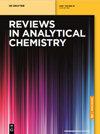用于化学战剂模拟物探测的化学传感器敏感材料研究进展
IF 3.8
3区 化学
Q2 CHEMISTRY, ANALYTICAL
引用次数: 2
摘要
化学战剂(CWAs)是在军事行动中用于杀死、伤害或使敌人丧失行动能力的化学物质。在现场检测痕量的有毒CWAs是非常重要的。与传统的CWA分析仪器方法相比,化学电阻式气体传感器具有体积小、速度快、价格便宜等优点。随着纳米制造技术和新型传感材料(如碳纳米管、石墨烯、黑磷等)的发展,化学电阻式气体传感器仍然是一个重要的研究课题。化学电阻式气体传感器根据敏感材料的类型分为三类:碳基和bp基材料、导电聚合物和金属氧化物半导体。简要分析了敏感材料的制备策略,包括氢键策略、纳米结构、形貌、掺杂效应、复合材料以及其他材料的应用方法,并对敏感材料和检测效果进行了总结。本文综述旨在为CWAs检测的化学电阻传感器的发展提供指导。图形抽象本文章由计算机程序翻译,如有差异,请以英文原文为准。
Progress of sensitive materials in chemiresistive sensors for detecting chemical warfare agent simulants: A review
Abstract Chemical warfare agents (CWAs) are chemical substances intended for use in military operations to kill, injure, or incapacitate an enemy. It is very important to detect toxic CWAs at trace levels on site. Compared with traditional CWA analysis instrument methods, chemiresistive gas sensors present advantages of being small, fast, and inexpensive. Chemiresistive gas sensors are still an important research topic with the development of nanofabrication technology and new kinds of sensing materials, including carbon nanotubes, graphene, and black phosphorus (BP). Chemiresistive gas sensors are divided into three categories according to the type of sensitive materials: carbon- and BP-based materials, conductive polymers, and metal oxide semiconductors. A brief analysis was carried out on fabrication strategies using sensitive materials, including hydrogen bonding strategies, nanostructures, morphology, doping effects, composite materials, and other material application methods, and the sensitive materials and detection effects are summarized in this study. This review aims to provide guidance in the development of chemiresistive sensors for the detection of CWAs. Graphical abstract
求助全文
通过发布文献求助,成功后即可免费获取论文全文。
去求助
来源期刊

Reviews in Analytical Chemistry
化学-分析化学
CiteScore
7.50
自引率
0.00%
发文量
15
审稿时长
>12 weeks
期刊介绍:
Reviews in Analytical Chemistry publishes authoritative reviews by leading experts in the dynamic field of chemical analysis. The subjects can encompass all branches of modern analytical chemistry such as spectroscopy, chromatography, mass spectrometry, electrochemistry and trace analysis and their applications to areas such as environmental control, pharmaceutical industry, automation and other relevant areas. Review articles bring the expert up to date in a concise manner and provide researchers an overview of new techniques and methods.
 求助内容:
求助内容: 应助结果提醒方式:
应助结果提醒方式:


